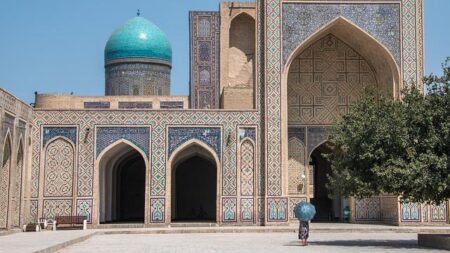Title: Exploring Economic Dynamics: GDP Growth in Eswatini, Lesotho, and South Africa
In the face of global economic uncertainties, the Southern African region reveals distinct economic patterns through its gross domestic product (GDP) growth. Recent findings from ResearchGate shed light on the annual GDP fluctuations in three neighboring countries: Eswatini, Lesotho, and South Africa. Despite their geographical closeness, these nations exhibit divergent economic paths influenced by varying political climates, resource management strategies, and external factors.This article investigates the current state of these economies by analyzing growth drivers or stagnation points while considering implications for regional advancement and investment prospects that affect millions of lives. For policymakers and stakeholders navigating this intricate landscape, grasping the nuances of GDP changes in Eswatini, Lesotho, and South Africa is vital for promoting sustainable economic advancement.
Economic Overview: GDP Growth Trends in Eswatini, Lesotho, and South Africa
The economic narratives of Eswatini, Lesotho, and South Africa present a interesting mix of growth opportunities alongside notable challenges unique to each country. Current statistics reveal that while South Africa—the largest economy in this region—has shown signs of gradual recovery following pandemic disruptions; its GDP growth remains tepid due to structural challenges coupled with high unemployment rates. Conversely,Eswatini is witnessing modest expansion fueled by agricultural exports along with a slow resurgence in tourism; however it contends with issues related to political stability as well as elevated youth unemployment levels. Meanwhile,Lesotho faces a complex economic surroundings characterized by potential within its textile sector but hindered by pressing public sector reform needs that impact overall growth.
A comprehensive analysis of recent years’ GDP percentages necessitates consideration of several key influencing elements:
- Export Performance: The reliance on exports such as textiles for Lesotho and agriculture for Eswatini plays a crucial role.
- Political Stability: The solid political framework found in South Africa starkly contrasts with the instability experienced by its neighbors.
- Foreign Investment: Investment levels across these nations vary significantly based on global market conditions.
| Nations | Anual % Change in GDP | Main Contributors to Growth |
|---|---|---|
| Eswatini | 2.5% | Agriculture & Tourism Sectors |
| Lesotho | 1 .8 % | Textiles & Services Sector |
| South Africa | 0 .9 % | Mining & Manufacturing Industries |
Regional Economic Performance: Challenges & Opportunities Ahead
The Southern African region’s economy—especially within Eswatini ,Lesotho ,and South Africa—is shaped by an intricate blend of obstacles alongside opportunities.The structural challenges, including high unemployment rates coupled with poverty levels continue hindering sustained progress .As an example,The economyofEs wat ini relies heavily upon agriculture along with remittances making it susceptible towards climatic variations alongwith external shocks.
In contrast ,Lesoth o’s mountainous geography poses significant logistical hurdles impacting trade dynamics while(South Afric a’s diverse economy grapples )with inequalities leading towards sluggish overall regional advancement .Nevertheless ,these very challenges can act as catalysts prompting innovation demanding diversification enhancing resilience against outside pressures.
<
> Numerous opportunities exist through regional integration paired alongside cooperative policies aimed at bolstering economies.The establishmentofAfrican Continental Free Trade Area (AfCFTA)> provides an avenue enabling these countries expanding trade capabilities fostering stronger ties which could result into improved infrastructure investments collaboration particularly renewable energy technology sectors potentially boosting collective gdp across regions.Additionally implementing social development initiatives focusing education skills training equips workforce meeting demands evolving global marketplace.Prioritizing sustainability practices embracing innovation allows es wat ini lesoth o south africa transforming adversities pathways towards prosperity.
<
>
<
>
Strategic Pathways Towards Sustainable Economic Growth Across Southern African Economies Â
>
Taking into account prevailing trends observed within es wat ini lesoth o south africa adopting multifaceted approaches becomes imperative nurturing sustainable advancements throughout this area.Addressing underlying structural deficiencies remains paramount.Policymakers ought prioritize strengthening infrastructure facilitating trade investments especially transportation energy sectors.Furthermore enhancing educational vocational training ensures workforce equipped requisite skills thereby increasing productivity.Additional recommendations include :
- P romoting entrepreneurship driving innovation creating job prospects.
- I mplementing prudent fiscal policies maintaining financial stability.
- P romoting collaborative efforts leveraging collective bargaining power expanding market access.
Additionally establishing partnerships between public private sectors mobilizes resources enhances technological transfer.A complete focus uponsustainable practices becomes essential particularly industries like agriculture mining where environmental concerns grow increasingly relevant.To effectively monitor progress,a framework tracking developmental indicators should be instituted encompassing :
“Indicator” “ “Es wat ini” “Lesoth o” “South Afric a” “Current G DP Growth Rate “ “2 .1 %” ” “2.5 %” ” “3 .0 %” “ > <tr /
"”
“<d"
"<d
"<d
"<d
"<t<h3 id=outroFinal Thoughts/h3
To conclude,the gdp fluctuations exhibited among es wat ini lesoth o south africa unveil substantial narratives reflecting broader dynamics characterizing southern african economies.Although dominant player,south africas struggles may influence future trajectories both es wat ini les oth navigate distinct paths amidst global uncertainties.Divergence seen amongst their respective rates underscores varying impacts stemming from domestic policies socio-economic conditions external influences.As we move forward,sustainability surrounding these patterns hinges largely upon adaptability resilience implementation inclusive policy frameworks.For investors stakeholders understanding emerging trends proves critical formulating strategies stimulating activity addressing persistent issues such as inequality unemployment.
As local international entities keep close watch over developments unfolding,economic journeys undertaken will undoubtedly serve pivotal barometers gauging overall health southern african landscape.
- I mplementing prudent fiscal policies maintaining financial stability.







